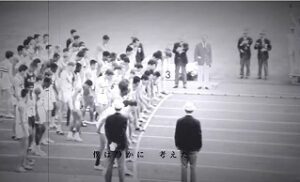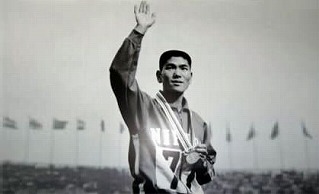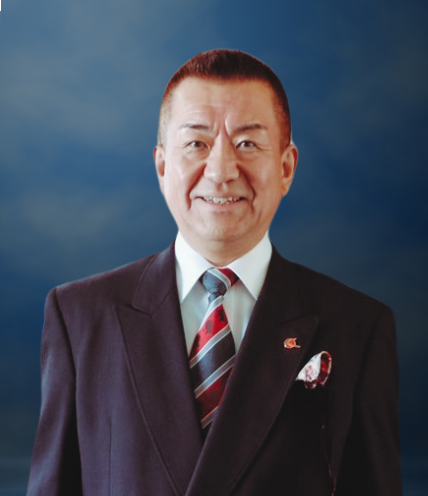
渡邉 晃人 Akihito Watanabe
静岡県警 元警部(刑事部機動捜査隊東部支隊長)
在籍42年 刑事歴34年 2019年退官
現在 日本刑事技術協会所属 講演講師
保護司/青少年指導員/薬物乱用防止委員
行政書士 AKITO21 法務相談事務所代表
防犯落語家(にか奴亭三助) 企業専属顧問
一般社団法人日本刑事技術協会所属講師
Akihito Watanabe
Former Inspector, Shizuoka Prefectural Police
(Chief of the Eastern Branch, Criminal Investigation Unit)
42 years of service, 34 years of criminal investigation experience, retired in 2019
Currently a lecturer with the Japan Criminal Technology Association
Probation officer / Youth guidance counselor / Drug abuse prevention committee member
Administrative scrivener, Representative of AKITO21 Legal Consultation Office
Crime prevention Rakugo performer (Nikkyutei Sansuke), Corporate advisor
Lecturer with the Japan Criminal Technology Association
表題タイトルに戻る
私が生まれた1959年 戦後14年が経った日本の歩み
私が産声を上げた1959年、それは日本が長く続いた戦後の傷跡から立ち上がり、目覚ましい発展への序章を奏で始めた年でした。
焼け野原から力強く立ち上がった国は、池田勇人内閣による所得倍増計画を目前に控え、未来への希望に胸を膨らませた国民の熱気に満ち溢れていました。
街には、電気洗濯機、電気冷蔵庫、そして白黒テレビという「三種の神器」が家庭に浸透し始め、人々の生活様式は劇的な変化を遂げつつありました。
それまで想像もできなかった家電製品がもたらす利便性は、日々の暮らしに彩りとゆとりを与え、新たな時代の到来を予感させました。
自動車もまた、徐々にその姿を街で見かけるようになり、マイカーブームという言葉が囁かれ始めるなど、生産力の向上と所得の増加は、人々の消費意欲を力強く刺激しました。銀座や新宿には、きらびやかな百貨店や最新の品々が並ぶスーパーマーケットが次々と誕生し、それらは単なる買い物をする場ではなく、新しい消費文化が花開く舞台となりました。
経済成長の陰で、地方から都市への人口移動は加速の一途を辿り、都市部では住宅不足や通勤ラッシュといった新たな課題が顕在化し始めました。そして、それはやがて深刻な公害問題へと発展していく萌芽でもありました。
しかし、社会全体は明るい話題にも沸き立っていました。皇太子明仁親王と正田美智子様のご成婚は、全国民が祝福する慶事となり、「ミッチー・ブーム」と呼ばれる空前の社会現象を巻き起こしました。皇室に新たな光が灯ったことは、人々に希望と喜びを与え、社会全体を明るく照らしました。
若者の間では、ロカビリーなどの新しい音楽やファッションが旋風を巻き起こし、既成の価値観にとらわれない、エネルギッシュな新しい世代の台頭が鮮やかに感じられました。大衆娯楽の中心にはテレビが据えられ、プロレスや歌謡番組は家族団らんのひとときを彩りました。映画産業も黄金期を迎え、人々の心を魅了する数々の名作が生み出されました。そして、未来の少年たちの心を掴む『週刊少年マガジン』と『週刊少年サンデー』が創刊され、日本独自の少年漫画文化が大きく発展していく礎が築かれたのです。
その一方で、自然の猛威は時に容赦なく人々を襲いました。伊勢湾台風は、甚大な被害をもたらし、防災対策の重要性を改めて社会に深く刻み込みました。
社会の変革は、労働者の意識にも変化をもたらしました。高度経済成長を背景に、労働者の権利意識が高まり、労働組合の活動は活発化の一途を辿りました。さらに、翌年に控えた日米安全保障条約の改定をめぐっては、国民の間で激しい議論が交わされ、安保闘争という大きな社会運動へと発展していきました。そして、世界に目を向ければ、米ソを中心とした東西冷戦は依然として続き、世界は緊張感に包まれていました。しかし、アジアやアフリカでは、長きにわたる植民地支配から解放され、新たな独立国家が次々と誕生し、国際社会の勢力図は大きく塗り替えられようとしていました。また、人類の夢を乗せた宇宙開発競争が幕を開け、科学技術は目覚ましい速さで進歩を遂げていました。このように、私が生まれた1959年は、日本が戦後の苦難を乗り越え、力強い経済成長の道を歩み始めた、まさに希望と変革の息吹に満ちた時代でした。同時に、自然の脅威や社会的な課題も顔を覗かせ始め、社会全体が大きなうねりの中で、目覚ましい発展と、それに伴う変化を肌で感じていた、かけがえのない昭和の良き時代だったと言えるでしょう。
この豊かな時代を築き上げてくれた先人たち、そして祖国のために尊い命を捧げた英霊の方々に、改めて深い敬意と感謝の念を捧げたいと思います。
The 1959s, The Year I Was Born
The year I was born, 1959, marked the beginning of a remarkable period of growth for Japan as it rose from the long shadow of the post-war era. The nation, having powerfully recovered from the devastation of war, was on the cusp of Prime Minister Hayato Ikeda’s Income Doubling Plan, and the air was thick with the hopeful anticipation of its people for the future.
On the streets, the “Three Sacred Treasures” of the time – electric washing machines, electric refrigerators, and black and white televisions – began to permeate households, dramatically changing people’s lifestyles. The convenience brought by these previously unimaginable home appliances added color and余裕 to daily life, heralding the arrival of a new era.
Automobiles also gradually became a more common sight in the cities, and whispers of a private car boom began to circulate. Increased production capacity and rising incomes strongly stimulated people’s desire to consume. In Ginza and Shinjuku, dazzling department stores and supermarkets showcasing the latest goods sprang up one after another, becoming not just places for shopping but stages where a new consumer culture blossomed.
In the shadow of this economic growth, the migration of people from rural areas to cities accelerated, and urban areas began to face new challenges such as housing shortages and traffic congestion. This also marked the early stages of what would eventually develop into serious pollution problems.
However, society as a whole was also filled with bright news. The marriage of Crown Prince Akihito and Michiko Shoda was a joyous occasion celebrated by the entire nation, sparking an unprecedented social phenomenon known as the “Mitchy Boom.” The new light that shone upon the Imperial Family brought hope and joy to the people, brightly illuminating society as a whole.
Among young people, new music and fashion like rockabilly swept through, vividly signaling the emergence of an energetic new generation unfettered by conventional values. Television became the center of popular entertainment, with professional wrestling and popular music programs providing moments of family togetherness. The film industry also enjoyed a golden age, producing numerous masterpieces that captivated people’s hearts. Furthermore, the launch of “Weekly Shonen Magazine” and “Weekly Shonen Sunday,” which would capture the hearts of future boys, laid the foundation for the significant development of Japan’s unique manga culture.
On the other hand, the forces of nature sometimes struck mercilessly. Typhoon Vera (Isewan Typhoon) caused immense damage, deeply engraving the importance of disaster prevention measures into society’s consciousness.
Social changes also brought about a shift in the awareness of workers. Against the backdrop of rapid economic growth, workers became more conscious of their rights, and the activities of labor unions steadily intensified. Furthermore, the upcoming revision of the U.S.-Japan Security Treaty the following year sparked vigorous debate among the public, leading to the large-scale social movement known as the Anpo Protests.
Looking at the world, the Cold War, centered on the United States and the Soviet Union, continued, and the world remained in a state of tension. However, in Asia and Africa, many countries were liberated from long periods of colonial rule, and new independent nations emerged one after another, significantly reshaping the international power map. The space race, carrying humanity’s dreams, also began, and science and technology advanced at a remarkable pace.
Thus, the year I was born, 1959, was truly an era filled with the spirit of hope and change, as Japan overcame the hardships of the post-war period and began its vigorous journey towards economic growth. At the same time, the threats of nature and emerging social issues began to surface, and society as a whole, amidst great waves of change, tangibly experienced remarkable development and its accompanying transformations. It was a precious and good old Showa era.
I would like to once again express my deepest respect and gratitude to the predecessors who built this prosperous era and to the war heroes who dedicated their precious lives for our country.
平和の礎
From the Cornerstone of Peace
無辜の民の涙の上に、平和は咲き誇る。
繰り返される犠牲、その上に築かれる脆き平和とは、どれほどの尊い犠牲の上に成りたっているのだろうか。
【意味】「無辜の民(むこのたみ)」何の罪もないのに被害を受けた人々のこと。
Peace blooms brilliantly upon the tears of innocent people.
Repeated sacrifices, upon which this fragile peace is built – upon how many precious sacrifices does it stand?
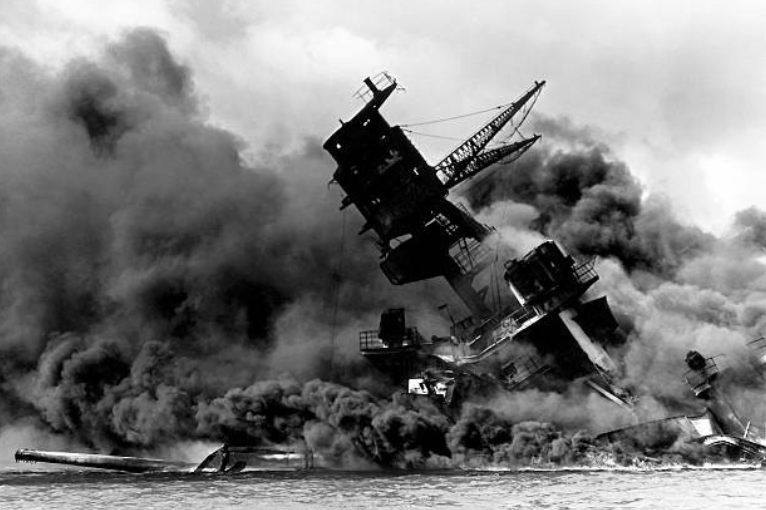
表題タイトルに戻る
ハワイ真珠湾奇襲
1941年12月8日ハワイ真珠湾奇襲
「ニイタカヤマノボレ」1208(ヒトフタマルハチ)暗号電文日本海軍はハワイ北方425キロに達した機動部隊から計350機の航空部隊が発進し、オアフ島の真珠湾に停泊していた米艦隊を攻撃。これにより、太平洋戦争が始まった。
The Pearl Harbor Attack in Hawaii
On December 8, 1941, the Pearl Harbor attack in Hawaii occurred. The coded message “Niitakayama nobore 1208” (Climb Mount Niitaka 1208) was sent. The Japanese Navy launched a total of 350 aircraft from its mobile fleet, which had advanced to 425 kilometers north of Hawaii, and attacked the U.S. fleet anchored in Pearl Harbor on Oahu Island. As a result, the Pacific War began.
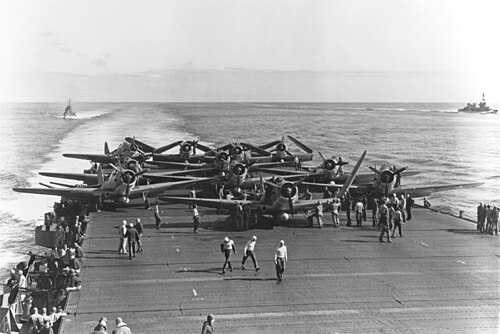
表題タイトルに戻る
ミッドウェー海戦
1942年6月5日ミッドウェー海戦日本機動部隊は、暗号解読班がニセ電文を発してアメリカ軍に誤情報を流し、戦局を有利に進めたが日本軍は空母四隻と航空機300機を失う大敗退を期した。制空権と制海権を失ったことで戦局の主導権は、アメリカ側に移った。
The Battle of Midway
On June 5, 1942, in the Battle of Midway, the Japanese Mobile Fleet sent false information to the American forces by transmitting coded messages, which advanced the battle situation favorably for Japan. However, the Japanese forces suffered a crushing defeat, losing four aircraft carriers and 300 aircraft. By losing control of the skies and the seas, the initiative in the battle shifted to the American side.

表題タイトルに戻る
特別攻撃隊
1944年10月25日未来ある平均年齢21.6歳の若者たちが、神風特別攻撃隊と回天特別攻撃隊による悲劇的な自爆攻撃で命を落とした。戦闘機には250㎏の爆弾が搭載され、回天には1.5tもの爆薬が積まれていた。
Special Attack Units
October 25, 1944, The U.S. Forces Arrive
Young men with an average age of 21.6 years lost their lives in tragic suicide attacks by the Kamikaze Special Attack Units and Kaiten Special Attack Units.
Fighter planes were loaded with 250kg bombs, and Kaiten torpedoes carried 1.5 tons of explosives.
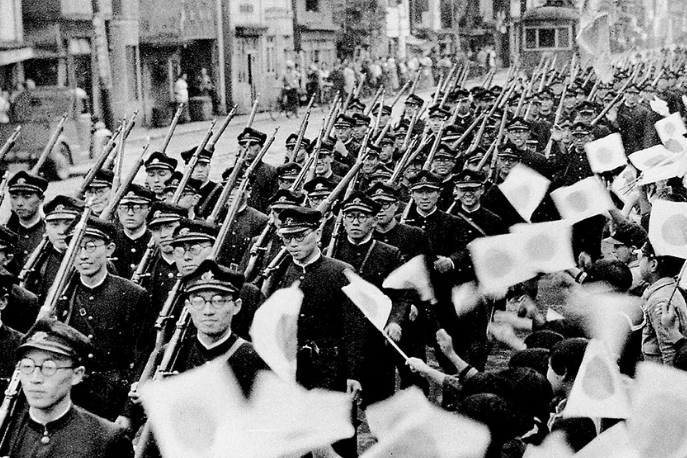
表題タイトルに戻る
学徒出陣
1944年10月、第二次世界大戦末期の兵力不足を深刻化させた日本政府は、大学や旧制中学校などの文化系学生を対象に学業を中断させ、戦地に送る学徒出陣を決定し壮行式が行われた。
Mobilization of Student Soldiers
October 1944: Mobilization of Student Soldiers
A send-off ceremony where students were burdened with the lack of military strength in the final stages of World War II. The Japanese government ordered students of humanities and normal schools, among others, to suspend their studies and mobilized them to the battlefield.
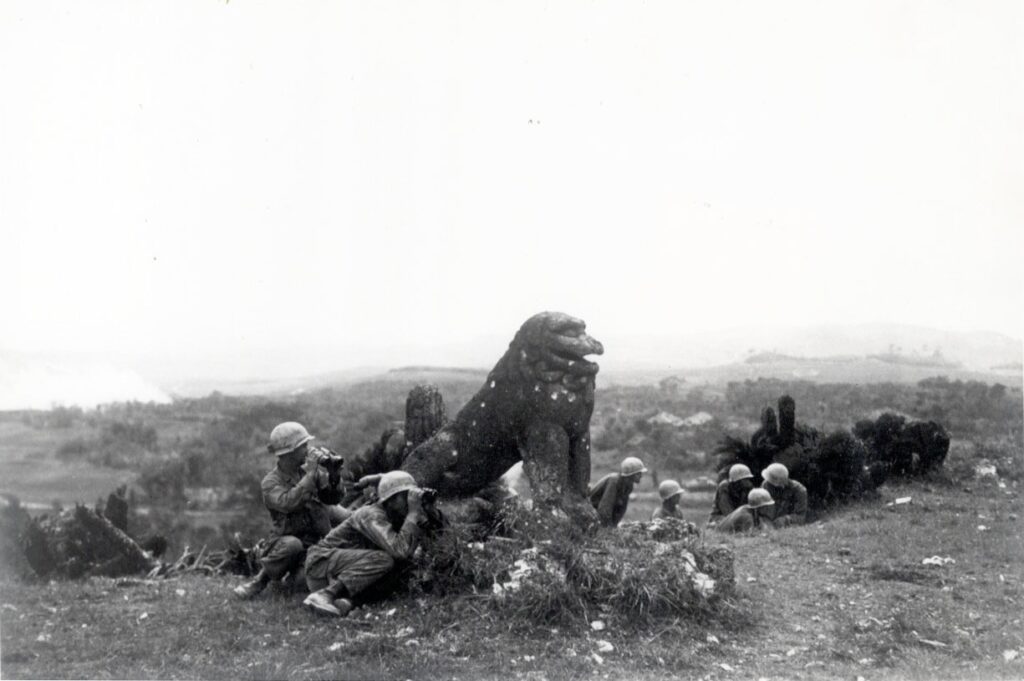
表題タイトルに戻る
沖縄戦
1945年3月26日アメリカ軍上陸
日本軍の激しい抵抗と悲惨な沖縄戦により、20万人もの命が失われた。その中には、ひめゆり学徒隊沖縄県立第一女子女学校と沖縄師範学校女子部で構成された女子学徒隊が看護要員として動員され、その多くが犠牲となった。
The Battle of Okinawa
March 26, 1945: American Forces Land
Japanese forces’ desperate defense of Okinawa. In the fierce battle of Okinawa, approximately 200,000 lives were lost. Among them were the Himeyuri Student Corps, composed of female students from Okinawa Daiichi Girls’ High School and Okinawa Shihan Girls’ High School, who served as nursing assistants, and many of them died tragically.

表題タイトルに戻る
原子爆弾の悲劇
1945年8月6日午前8時15分、テニアン島(北マリアナ諸島)から飛び立ったアメリカ軍のB29爆撃機「エノラ・ゲイ」は、広島市上空で人類史上初の殺戮兵器である原子爆弾「リトルボーイ」(ウラン235型)を無慈悲にも投下した。この一瞬の爆発により、熱線、爆風、放射線が広範囲に及び、推定で約14万人の尊い命が奪われた。さらに、7万4,909人もの人々が重軽傷を負い、その後の人生においても放射線による後遺症に苦しむこととなる。
そのわずか3日後の1945年8月9日午前11時2分、アメリカ軍は再び長崎市に対して2発目の原子爆弾「ファットマン」(プルトニウム239型)を投下した。これにより、推定で7万3,884人が死亡し、7万4,909人が重軽傷を負い、広島と長崎への二度の原子爆弾投下は、合計で14万8,793人もの犠牲者を出し、罪のない多くの人々の命を一瞬にして奪い去ってしまった。これらの悲劇は、核兵器の非人道性と破壊力を世界に強く示し、二度と繰り返してはならない人類の過ちとして、深く記憶されるべき出来事となった。
補足事項
・広島の死者数は、1945年末までに約14万人と推計されているが、その後の調査でさらに増加しており、現在では20万人を超えるとも言われている。
・長崎の死者数も同様に、爆撃直後だけでなく、その後の放射線による影響で亡くなった方々を含めると、さらに増加している。
・重軽傷を負った方々の中には、生涯にわたり後遺症に苦しみ、社会生活に大きな困難を抱えた方も少なくない。
・原子爆弾は、単に人命を奪うだけでなく、街を破壊し、人々の生活基盤を根こそぎ破壊した。これらの出来事は、核兵器廃絶と恒久平和の実現に向けた強い教訓として、現代に生きる私たちに深く刻まれている。
The Tragedy of the Atomic Bombings
At 8:15 AM on August 6, 1945, the American B-29 bomber “Enola Gay,” which had taken off from Tinian Island (Northern Mariana Islands), mercilessly dropped the atomic bomb “Little Boy” (uranium-235 type), humanity’s first weapon of mass destruction, over Hiroshima City. This instantaneous explosion unleashed heat rays, blast waves, and radiation over a wide area, claiming the precious lives of an estimated 140,000 people. Furthermore, 74,909 individuals suffered severe or minor injuries, and many would continue to suffer from the aftereffects of radiation throughout their lives.
Just three days later, at 11:02 AM on August 9, 1945, the American military again dropped a second atomic bomb, “Fat Man” (plutonium-239 type), on Nagasaki City. This resulted in an estimated 73,884 deaths and 74,909 severe or minor injuries. The two atomic bombings of Hiroshima and Nagasaki claimed a total of 148,793 victims, instantly taking the lives of countless innocent people. These tragedies starkly demonstrated the inhumanity and destructive power of nuclear weapons to the world and should be deeply remembered as a human error that must never be repeated.
Additional Notes:
・ The number of deaths in Hiroshima is estimated to be approximately 140,000 by the end of 1945, but subsequent investigations have shown further increases, with some estimates now exceeding 200,000.
・ Similarly, the death toll in Nagasaki has also increased beyond the immediate aftermath of the bombing, including those who died from the effects of radiation in the following years.
・ Among those who suffered severe or minor injuries, many endured lifelong aftereffects and faced significant difficulties in their social lives.
・ The atomic bombs not only claimed countless lives but also destroyed cities and completely devastated the foundations of people’s lives. These events serve as a powerful lesson for us who live in the present day, strongly emphasizing the need for the abolition of nuclear weapons and the realization of lasting peace.
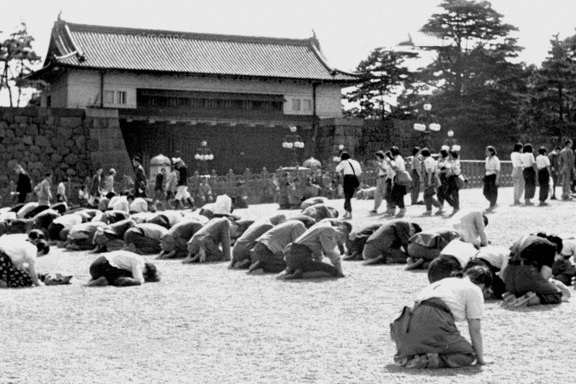
表題タイトルに戻る
終戦宣言
1945年8月15日、日本はポツダム宣言を受諾し、昭和天皇による終戦の詔書(大東亜戦争終結に関する詔書)がラジオ放送(玉音放送)を通じて国民に伝えられた。「堪え難きを堪え、忍び難きを忍び」という有名な一節を含む詔書で、天皇は世界の情勢と日本の現状を深く考慮し、非常の措置として終戦を決断したことを国民に告げた。この放送を聞いた多くの日本国民は、敗戦という現実を受け止め、悲しみに暮れた皇居門前のスナップ写真が物語っている。
End of the War Proclamation
On August 15, 1945, Japan accepted the Potsdam Declaration, and Emperor Showa’s rescript on the end of the war (the rescript concerning the conclusion of the Greater East Asia War) was conveyed to the nation via radio broadcast (the Jewel Voice Broadcast).
In the rescript, which included the famous phrase “enduring the unendurable, bearing the unbearable,” the Emperor deeply considered the state of the world and Japan’s current situation, and informed the nation of his decision to end the war through extraordinary measures. Many Japanese citizens who heard this broadcast accepted the reality of defeat, and a snapshot photograph in front of the Imperial Palace, shrouded in sorrow, tells the story.
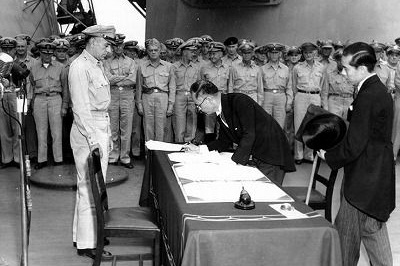
表題タイトルに戻る
日本無条件降伏調印
1945年9月2日、東京湾に停泊中の戦艦ミズーリ号の甲板にて、日本の無条件降伏調印式が行われました。日本の全権代表として、重光葵外務大臣と梅津美治郎参謀総長が出席した。
降伏調印までの経緯。
8月15日、終戦の詔勅が国民に告げられ 8月17日、鈴木貫太郎内閣が総辞職し、東久邇宮稔彦王内閣が成立した。8月30日、連合国軍最高司令官ダグラス・マッカーサーが日本に到着した。9月2日、東京湾の戦艦ミズーリ号上で、連合国に対する降伏文書の調印式が行われ、すべての戦闘が終結した。9月には、GHQ(連合国軍最高司令官総司令部)が本格的に活動を開始し、占領政策に着手する。GHQの指示による様々な改革が始まる中で、10月9日、東久邇宮稔彦王内閣が総辞職となる。後を受けた幣原喜重郎内閣は、マッカーサーからいわゆる「五大改革指令」を伝達されました。五大改革指令とは、1945年(昭和20)10月11日,連合国軍最高司令官マッカーサーが,新任挨拶の幣原喜重郎首相に対して口頭でのべた勧告。選挙権賦与による婦人の解放,労働組合の結成奨励,学校教育の自由主義化,圧制的諸制度の廃止,経済機構の民主化を内容とする。この結果,10月13日の国防安保・軍事保護法の廃止,10月15日の治安維持法廃止,10月22日の「日本教育制度に対する管理政策」指令,11月6日の財閥解体指令,11月21日の治安警察法廃止,12月17日の選挙法公布,12月22日の労働組合法公布などのかたちで着々と実現された。
Japan's Unconditional Surrender Signing
On September 2, 1945, the signing ceremony for Japan’s unconditional surrender took place on the deck of the battleship USS Missouri, anchored in Tokyo Bay. Japan’s plenipotentiary representatives were Foreign Minister Mamoru Shigemitsu and Chief of the Army General Staff Yoshijirō Umezu.
Events Leading Up to the Signing of the Surrender:
On August 15th, the Imperial Rescript on the Termination of the War was announced to the nation. On August 17th, the Kantarō Suzuki cabinet resigned en masse, and the Prince Naruhiko Higashikuni cabinet was formed. On August 30th, Supreme Commander for the Allied Powers Douglas MacArthur arrived in Japan. On September 2nd, the signing ceremony of the Instrument of Surrender to the Allied Powers took place on the USS Missouri in Tokyo Bay, marking the end of all combat. In September, the General Headquarters (GHQ) of the Allied Powers began its full-scale operations and commenced the occupation policies. Amidst various reforms initiated by GHQ’s directives, the Prince Naruhiko Higashikuni cabinet resigned en masse on October 9th. The succeeding Kijūrō Shidehara cabinet received the so-called “Five Great Reforms Directives” from MacArthur. The Five Great Reforms Directives were oral recommendations made by Supreme Commander for the Allied Powers MacArthur to newly appointed Prime Minister Kijūrō Shidehara during his introductory visit on October 11, 1945 (Showa 20). They included the emancipation of women through the granting of suffrage, the encouragement of labor union formation, the liberalization of school education, the abolition of oppressive institutions, and the democratization of the economic structure. As a result, these directives were steadily implemented in the form of the abolition of the National Defense and Military Protection Law on October 13th, the abolition of the Peace Preservation Law on October 15th, the directive on the “Administration Policy for the Japanese Educational System” on October 22nd, the directive on the dissolution of zaibatsu (financial cliques) on November 6th, the abolition of the Public Order Police Law on November 21st, the promulgation of the Election Law on December 17th, and the promulgation of the Labor Union Law on December 22nd.
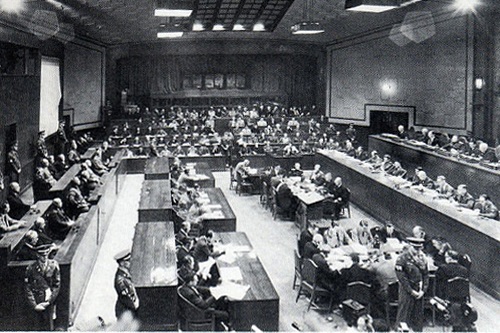
表題タイトルに戻る
極東国際軍事裁判
1946年5月3日極東国際軍事裁判 第二次世界大戦に関する極東国際軍事裁判は、第二次世界大戦における日本のA級戦犯を審理するために、1946年(昭和21年)5月から極東国際軍事裁判が始まった。日本で戦争の指導層となった軍人、政治家ら28人が起訴され、平和に対する罪、人道に対する罪などで裁かれた。被告らはあくまで自衛のための戦争だったと主張したが、1948年(昭和23年)11月の判決では、裁判中に死亡した被告などを除く25人が有罪となった。このうち、板垣征四郎、木村兵太郎、土肥原賢二、東条英機、広田弘毅、松井石根、武藤章の7人が死刑判決を受け、同年12月23日に絞首刑が執行された。
戦勝国インドの代表として東京裁判に参加したパール判事は、勝者が敗者を裁く戦争裁判の正当性に疑問を投げ掛け、被告全員の無罪を主張したことで有名である。
International Military Tribunal for the Far East
May 3, 1946, International Military Tribunal for the Far East
The International Military Tribunal for the Far East, concerning World War II, was convened in May 1946 (Showa 21) to try Japanese Class A war criminals. Twenty-eight military personnel, politicians, and others from Japan’s wartime leadership were indicted on charges including crimes against peace and crimes against humanity. While they consistently asserted that the war was for self-defense, the verdict in November 1948 (Showa 23) found 25 of the accused guilty, excluding those who died during the trial. Among them, seven individuals, including Hideki Tojo, Seishiro Itagaki, Heitaro Kimura, Kenji Doihara, Akira Muto, Iwane Matsui, and Kuniaki Koiso, were sentenced to death, and the sentences were carried out by hanging on December 23 of the same year.
Justice Radhabinod Pal, the representative of India on the Tokyo Tribunal, questioned the legitimacy of the war crime trials where the victors judged the defeated, and famously argued for the acquittal of all the accused.
表題タイトルに戻る
散華の調べ 生きて還れぬ「特攻」の慟哭(どうこく) 声を上げて激しく泣くさま
太平洋戦争末期、日本軍は窮地に追い込まれる中、特攻という悲壮な戦術に縋りました。それは、搭乗員が操る軍用機、小型艇、潜水艇を、敵艦船への体当たりという形で決行する、生還を期さない攻撃です。
この痛ましい作戦は、未来ある多くの若者の命を奪い去り、標的となった連合軍の兵士たちに筆舌に尽くしがたい恐怖を刻み込みました。中でも航空特攻は、終戦から77年の歳月を経た今なお、「KAMIKAZE(カミカゼ)」として、その衝撃とともに世界に語り継がれています。
昭和20年(1945年)3月に始まった沖縄戦において、日本軍は大規模な特攻作戦を展開しました。
その出撃基地は、鹿児島県、宮崎県、熊本県といった南九州に集中していました。
なぜ、祖国は若者を特攻へと駆り立てたのか
太平洋戦争は、昭和16年(1941年)12月8日、日本軍によるマレー半島と真珠湾への奇襲攻撃によって幕を開けました。しかし、翌昭和17年(1942年)のミッドウェー海戦や、ソロモン諸島を巡る激しい消耗戦で、日本軍は熟練の搭乗員と貴重な航空機を多数失い、工業力で圧倒的に勝るアメリカ軍に対し、徐々に劣勢へと転じていきました。昭和19年(1944年)6月のマリアナ沖海戦では、400機もの空母艦載機と3隻の空母を失い、日本軍は機動力を失い、戦局は絶望的な様相を呈します。
このような状況下、軍上層部は、太平洋で優位を確立した連合軍に対し、通常の攻撃では有効な対抗手段がないと判断。苦肉の策として、特攻による体当たり攻撃に活路を見出そうとしたのです。そして昭和19年(1944年)10月、第一航空艦隊司令長官に着任した大西瀧治郎中将の号令のもと、「神風特別攻撃隊」と名付けられた部隊が編成されました。
同年10月下旬、マッカーサー率いる大上陸部隊がフィリピンのレイテ島に侵攻。これに対し、レイテ沖海戦においてフィリピンから出撃した神風特別攻撃隊は、護衛空母を撃沈するなど、一定の戦果を挙げました。この結果を受け、軍上層部は特攻をその後の主要な攻撃手段として位置づけるようになったのです。
焦土と悲劇 – 苛烈を極めた沖縄での特攻
昭和20年(1945年)3月、50万を超える連合軍部隊が沖縄に押し寄せました。
日本国内で唯一の地上戦となった「沖縄戦」の始まりです。
南九州を中心に、奄美群島、石垣島、台湾の基地から、沖縄本島周辺に展開する連合軍艦艇に向けて、数多くの特攻隊員が飛び立ちました。特に4月6日には、陸海軍合わせて300機もの戦闘機や爆撃機が、決死の体当たり攻撃を敢行したのです。
沖縄戦において、連合軍が被った艦船の損害は200隻以上に達しました。そのうち、40隻以上の駆逐艦が撃沈されるか、終戦まで戦線に復帰できないほどの甚大な被害を受けました。
通常の爆撃や雷撃であれば、軍艦は戦闘機による迎撃、対空砲火、巧みな操船によってある程度の防御が可能でした。しかし、搭乗員が文字通り身を挺して突入する特攻は、回避することが極めて困難でした。一隻の駆逐艦に対し、同時に5機の特攻機が襲いかかるという悲劇的な事例も記録されています。
若き魂の叫び – 出撃した特攻隊員の胸中
出撃した特攻隊員の多くは、20歳前後の若い青年たちでした。
陸軍少年飛行兵学校や予科練習生を経て戦場に送られた少年たち、学徒出陣によって動員された大学生もいました。
彼らは、”お国のため”に戦うことが当然とされ、戦場で命を散らすことが名誉であるという、戦争の時代特有の価値観の中で育ちました。
特攻隊員への志願は一応任意とされていましたが、実際には命令や指名も存在し、それを拒否することは許されない空気がありました。そのような状況下で、生還の可能性がほぼ皆無である特攻を前に、多くの若者が苦悩し、疑問を抱いていたことは想像に難くありません。
慶應義塾大学から学徒出陣した上原良司さんは、当時の日本という国家に対する深い憂慮を抱きながら、特攻の途につきました。
上原良司さんの言葉
「自由の勝利は明白なことだと思います」
「権力主義、全体主義の国家は一時的には隆盛であろうとも必ずや最後には敗れることは明白な事実です」「一器械である吾人何も云う権利もありませんが、ただ、願わくば愛する日本を偉大ならしめられん事を、国民の方々にお願いするのみです」
彼の言葉は、当時の若者たちの複雑な心情を鮮やかに映し出しています。
戦火に染まった故郷 – 南九州の空襲と犠牲
多くの特攻基地が存在した南九州は、連合軍による度重なる空襲に晒されました。
特攻機が出撃する飛行場や関連施設、軍需工場などが標的となり、多くの市民が犠牲となりました。
鹿児島県では、奄美群島から種子島、本土各地にかけて数十回に及ぶ空襲があり、3300人を超える尊い命が失われました。宮崎市では、5月11日にB29の爆撃を受け、集団下校中の小学生16人が犠牲になるという痛ましい事件も起こりました。
熊本県は、7月1日にサイパンから飛来したB29による大規模な空襲で焼け野原となった後も、米軍が占領した沖縄の基地から発進した戦闘機や爆撃機による空襲を何度も受けました。連合軍は、11月に予定していた鹿児島・宮崎への上陸作戦に先立ち、南九州の軍事施設とインフラを徹底的に破壊しようとしたのです。
慟哭の記録 – 沖縄戦における特攻の犠牲
沖縄戦における特攻での日本軍の死者は3000人余りに達しました。一方、攻撃を受けた連合軍側も5000人もの犠牲者を出しました。その多くは、未来を嘱望された20歳前後の若者たちでした。
4月6日、米掃海駆逐艦エモンズは、5機の特攻機による壮絶な体当たりを受けました。エモンズに乗艦していたアンソニー・エスポジトさんは、2021年のNHKの取材に対し、当時の凄惨な状況を次のように語っています。
「私は直撃を免れましたが、海面に死体がいくつも浮かびあたり一体は火の海と化しました。特攻機のエンジンとパイロットの死体を見ました。人生がこれからだという若者がカミカゼのパイロットになるなんて。恐ろしさに、私は海軍を去りました」
彼の言葉は、特攻という行為の非情さと、それが人々に与えた深い傷跡を物語っています。
戦後 – 特攻が問いかけるもの
昭和20年(1945年)6月23日、沖縄戦の組織的な戦闘は終結しました。その後、広島、長崎への原爆投下、ソ連の参戦を経て、日本はポツダム宣言を受諾。太平洋戦争、そして第二次世界大戦は終焉を迎えました。連合軍は、日本が降伏しない事態を想定し、宮崎・鹿児島両県への上陸作戦、そして関東への上陸作戦を計画していました。特攻と玉砕という、自らの命を敢えて投げ出す日本軍の戦い方に対抗するため、原爆や化学兵器の使用も視野に入れていたと言われています。
もし日本が降伏せず、本土上陸作戦が実行されていたならば、文字通り「一億玉砕」という未曽有の悲劇が現実のものとなっていたかも知れません。
特攻は、命を落とした若者たちだけでなく、その家族や友人、特攻機の製造に動員された人々など、数多くの人々の心を深く傷つけ、その非情な出来事は今も語り継がれています。
なぜ戦争は起こるのか、その中でなぜ人間の命はこれほどまでに軽んじられるのか、このような悲劇を生み出す世界の、社会の仕組みとは何なのか。これらの問いに対する明確な答えは、今もなお見出されていません。
散華していった若者たちの鎮魂の祈りとともに、私たちはこの悲劇の歴史から目を背けることなく、平和の尊さを深く胸に刻み続ける必要があります。
Requiem of Fallen Blossoms: The Heartrending Cry of the "Tokko" Pilots Who Never Returned Alive
In the final stages of the Pacific War, as the Japanese forces were driven into a desperate situation, they resorted to the tragic tactic of Tokko (special attack). This was an attack in which military aircraft, small boats, and submarines, operated by their crew, would ram into enemy warships, with no expectation of survival.
This devastating operation claimed the lives of many promising young individuals and etched indescribable fear into the minds of the Allied soldiers who were the targets. Among these, the aerial Tokko, even 77 years after the end of the war, is still known worldwide as “KAMIKAZE,” along with its shocking impact.
In the Battle of Okinawa, which began in March 1945 (Showa 20), the Japanese military launched large-scale Tokko operations. Their sortie bases were concentrated in southern Kyushu, including Kagoshima, Miyazaki, and Kumamoto prefectures.
Why did the homeland drive its young people to Tokko?
The Pacific War began on December 8, 1941 (Showa 16) with the Japanese military’s surprise attacks on the Malay Peninsula and Pearl Harbor. However, in the Battle of Midway in the following year, 1942 (Showa 17), and the fierce attrition battles around the Solomon Islands, the Japanese military lost many experienced pilots and valuable aircraft. Against the overwhelmingly superior industrial power of the American forces, they gradually fell into a disadvantageous position. In the Battle of the Philippine Sea in June 1944 (Showa 19), the loss of 400 carrier-based aircraft and three aircraft carriers deprived the Japanese military of its mobility, and the war situation took on a desperate aspect.
Under these circumstances, the military high command judged that conventional attacks were ineffective against the Allied forces, who had established dominance in the Pacific. As a desperate measure, they sought a way out through Tokko ramming attacks. Then, in October 1944 (Showa 19), under the command of Vice Admiral Takijiro Onishi, who had been appointed Commander of the First Air Fleet, units named “Kamikaze Special Attack Corps” were formed.
In late October of the same year, the large landing force led by MacArthur invaded Leyte Island in the Philippines. In response, the Kamikaze Special Attack Corps, sortied from the Philippines during the Battle of Leyte Gulf, achieved some success, including sinking escort carriers. As a result, the military high command came to position Tokko as a major offensive tactic thereafter.
Scorched Earth and Tragedy – The Fierce Tokko in Okinawa
In March 1945 (Showa 20), over 500,000 Allied troops surged into Okinawa. This marked the beginning of the “Battle of Okinawa,” the only ground battle fought on Japanese territory.
From bases mainly in southern Kyushu, as well as the Amami Islands, Ishigaki Island, and Taiwan, numerous Tokko pilots took off towards the Allied warships deployed around the main island of Okinawa. Particularly on April 6th, a total of 300 fighters and bombers from the army and navy carried out desperate ramming attacks.
In the Battle of Okinawa, the damage to Allied ships exceeded 200 vessels. Among these, more than 40 destroyers were sunk or suffered such extensive damage that they could not return to the front lines until the end of the war.
With conventional bombing and torpedo attacks, warships could achieve a certain level of defense through fighter interception, anti-aircraft fire, and skillful maneuvering. However, Tokko attacks, in which pilots literally threw themselves at their targets, were extremely difficult to avoid. Tragic instances were recorded where five Tokko aircraft simultaneously attacked a single destroyer.
The Cry of Young Souls – The Feelings of the Tokko Pilots Before Sortie
Many of the Tokko pilots who sortied were young men in their late teens and early twenties. They included boys sent to the battlefield after graduating from army youth aviation schools or preparatory pilot training programs, as well as university students mobilized through the student conscription.
They were raised in the unique values of the wartime era, where fighting “for the nation” was considered natural, and dying in battle was seen as an honor.
Volunteering for the Tokko corps was nominally voluntary, but in reality, orders and nominations existed, and there was an atmosphere where refusal was not permitted. Under such circumstances, it is not difficult to imagine that many young people struggled and harbored doubts in the face of Tokko, where the possibility of survival was virtually nil.
Ryoji Uehara, a student conscripted from Keio University, embarked on his Tokko mission while harboring deep concerns about the state of Japan at the time.
Words of Ryoji Uehara:
“I believe the victory of freedom is clear.”
“It is a clear fact that even if authoritarian and totalitarian states flourish temporarily, they will surely be defeated in the end.” “As a mere instrument, I have no right to say anything, but I simply pray that the people will make our beloved Japan great.”
His words vividly reflect the complex feelings of the young people of that time.
Homeland Stained by War – Air Raids and Sacrifices in Southern Kyushu
Southern Kyushu, which had many Tokko bases, was repeatedly subjected to air raids by the Allied forces. Airfields and related facilities from which Tokko aircraft sortied, as well as munitions factories, were targeted, and many civilians were犠牲 (sacrificed).
In Kagoshima Prefecture, there were dozens of air raids ranging from the Amami Islands to Tanegashima and various parts of the mainland, resulting in the loss of over 3,300 precious lives. In Miyazaki City, a tragic incident occurred on May 11th when a B-29 bombing killed 16 elementary school students on their way home from school in a group.
Kumamoto Prefecture was devastated by a large-scale B-29 air raid on July 1st, which flew in from Saipan. Even after that, it was repeatedly attacked by fighters and bombers launched from bases in Okinawa occupied by the US military. Prior to the planned landings on Kagoshima and Miyazaki in November, the Allied forces sought to thoroughly destroy military facilities and infrastructure in southern Kyushu.
Records of Lamentation – Tokko Casualties in the Battle of Okinawa
The number of Japanese military personnel killed in Tokko attacks during the Battle of Okinawa exceeded 3,000. On the other hand, the Allied forces who were attacked also suffered 5,000 casualties. Many of these were promising young men in their late teens and early twenties.
On April 6th, the American minesweeper destroyer Emmons was subjected to a fierce ramming attack by five Tokko aircraft. Anthony Esposito, who was on board the Emmons, spoke to NHK in 2021 about the horrific situation at the time:
“I avoided a direct hit, but there were many bodies floating on the sea surface, and the entire area was a sea of fire. I saw the engine of a Tokko plane and the pilot’s body. For a young man whose life was just beginning to become a Kamikaze pilot… The horror made me leave the Navy.”
His words tell the story of the ruthlessness of the Tokko act and the deep wounds it inflicted on people.
Post-War – What Tokko Asks of Us
On June 23, 1945 (Showa 20), organized combat in the Battle of Okinawa ended. Subsequently, following the atomic bombings of Hiroshima and Nagasaki and the Soviet Union’s entry into the war, Japan accepted the Potsdam Declaration. The Pacific War and World War II came to an end. The Allied forces, anticipating a situation where Japan would not surrender, had planned landing operations in Miyazaki and Kagoshima prefectures, as well as a landing operation in the Kanto region. It is said that they were considering the use of atomic and chemical weapons to counter the Japanese military’s fighting methods of Tokko and Gyokusai (honorable suicide), in which they deliberately sacrificed their lives.
If Japan had not surrendered and the mainland landing operation had been carried out, an unprecedented tragedy of “one hundred million deaths” might have become a reality.
Tokko deeply wounded not only the young men who lost their lives but also their families and friends, as well as the people mobilized to manufacture the Tokko aircraft. This tragic event continues to be recounted today.
Why do wars occur? Why are human lives so easily disregarded in them? What are the mechanisms in the world and society that create such tragedies? Clear answers to these questions have yet to be found.
Along with prayers for the souls of the young men who fell in battle, we must not turn away from this tragic history and continue to deeply engrave the preciousness of peace in our hearts.
戦後初となる東京オリンピック開幕
The First Post-War Tokyo Olympics Opening
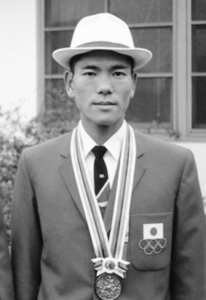
東京オリンピック
銅メダリスト
円谷幸吉 選手
表題タイトルに戻る
日の丸を背負った円谷幸吉選手の魂を胸に
私が5歳を迎えた1964年、戦後初となる高度成長期の幕開けを告げる東京オリンピックが開催されました。その熱狂のさなか、10月21日、一人のマラソンランナーが日本中を歓喜の渦に巻き込みました。東京オリンピックマラソン競技で銅メダルを獲得した円谷幸吉選手です。
彼の走りには、常に未来を見据え、限界のその先へ挑み続ける、不屈の精神が宿っていました。その類まれなる日本人選手の姿は、世界中の人々の心を揺さぶり、希望と感動を与えてくれました。円谷選手の生き様は、私の人生に深く刻まれ、かけがえのない道標となっています。
円谷幸吉選手が私たちに遺してくれたものは、決して色褪せることのない、未来への希望です。彼の魂は、これからも私たちの胸の中で輝き続け、勇気を与え続けてくれるでしょう。
https:// 東京オリンピックマーチ
With the Spirit of Kōkichi Tsuburaya in Our Hearts
The Hope That Kōkichi Tsuburaya Lit in My Future
In 1964, when I turned five, the Tokyo Olympics, heralding the dawn of Japan’s period of rapid economic growth, were held. Amidst the excitement, on October 21st, a marathon runner swept the nation into a whirlwind of joy. That runner was Kōkichi Tsuburaya, who won the bronze medal in the Tokyo Olympics marathon.
His running was imbued with an indomitable spirit, always looking to the future and continuing to challenge beyond his limits. His extraordinary figure shook the hearts of people around the world, giving them hope and inspiration. Tsuburaya’s way of life is deeply etched in my life and has become an irreplaceable guidepost.
What Kōkichi Tsuburaya left us is an undying hope for the future. His spirit will continue to shine in our hearts, giving us courage.
https:// Tokyo Olympic March
表題タイトルに戻る
渡邉晃人 学び
父の教えと純粋
幼少の円谷幸吉は、父の厳格な教えを受け、純粋な心を育んだ。
運動会のトラックで先頭を走る彼が、ふと後ろを振り返ると、父から雷のような叱責が飛んだ。
「男が走り出したからには、前だけを見ろ。後ろを振り返るのは卑怯者のすることだ!」と。その言葉は少年の心に深く刻まれ、彼はレース中、二度と後ろを振り返らなかった。
オリンピックの光と影
東京オリンピックのマラソン競技、残りわずかでイギリスのヒートリー選手が猛追し、最後のコーナーで円谷選手を追い抜いた。ヒートリー選手は後に「あれは円谷選手の戦意喪失を狙った作戦だった」と語った。その言葉通り、円谷選手はラストスパートに追いつく力を失い、ゴール後には深い失望と疲労の色が滲み出ていた。
7万5千人の声援
当時の国立競技場は、7万5千人の観客で埋め尽くされていた。彼らは円谷選手に声援を送ったが、その声は彼の耳には届かなかった。彼には応援と喜びの声だけが聞こえていた。「危ない!後ろから来ているぞ!抜かれるな!」という必死の叫び声も、彼の耳には届かなかった。
もしも、あの時
もし円谷選手が父の教えに背き、レース中に一度でも後ろを振り返っていたら、結果は違っていたかもしれない。しかし、父の教えを守り、「ゴールを目指してひたすら走り続ける」彼の姿は、多くの人の心を打ち、感動を呼んだ。
人生の教訓
しかし、人生においては「時には後ろを振り返り、現状を確認する」ことも大切なのではないか。
円谷選手の東京オリンピックでのレースは、人生の教訓を与えてくれました。私は、このような素晴らしいランナーと巡り会えたことを誇りに思っています。
Akito Watanabe: A Memoir
Father’s Teachings and Purity
In his childhood, Kōkichi Tsuburaya nurtured a pure heart under the strict teachings of his father. On the track of a school sports day, as he led the race, he glanced back, only to be met with a thunderous scolding from his father. “Once a man starts running, he looks only forward. Looking back is the act of a coward!” These words were deeply etched into the boy’s heart, and he never looked back during a race again.
The Light and Shadow of the Olympics
In the marathon at the Tokyo Olympics, with only a short distance remaining, Great Britain’s Heatley made a fierce追走, overtaking Tsuburaya at the final corner. Heatley later said, “It was a strategy aimed at breaking Tsuburaya’s fighting spirit.” True to his words, Tsuburaya lost the strength to make a final spurt, and after the goal, a deep sense of disappointment and exhaustion was evident on his face.
The Cheers of 75,000
The National Stadium at that time was filled with 75,000 spectators. They cheered for Tsuburaya, but their voices did not reach his ears. He could only hear the sounds of support and joy. The desperate cries of “Danger! He’s coming from behind! Don’t let him pass!” did not reach his ears.
If, at That Moment
If Tsuburaya had disobeyed his father’s teachings and looked back even once during the race, the outcome might have been different. However, his figure, adhering to his father’s teachings and “continuing to run single-mindedly towards the goal,” struck a chord with many people and evoked deep emotion.
A Lesson for Life
However, in life, isn’t it also important to “sometimes look back and check the current situation”? Tsuburaya’s race in the Tokyo Olympics provided us with a lesson for life.
平和と繁栄の彼方へ アメリカ遙かなる旅路
To the Other Side of Peace and Prosperity – A Long Journey to America
憧憬を胸に、輝く夢を追いかけて
幼き日の私は、刑事という名の星を追いかけていました。遥か海の向こう、アメリカの土を踏み、パールハーバーの煌めきをこの目に焼き付けたいと願っていました。中学時代、その夢は私の心を焦がし、靴底をすり減らしては憧れの円谷幸吉選手の背中を追い求め、陸上に青春を捧げました。やがて、私は警察官となり、22歳という若さで夢を叶えました。あの頃の過ぎた夢は、今も私の胸の中で輝き続け、人生という足跡を彩るかけがえのない宝物となっています。
With longing in my heart, I chase after my shining dreams
As a child, I chased after a star called detective. I longed to set foot on the soil of the American mainland, across the distant sea, and to burn the sparkle of Pearl Harbor into my eyes. During my junior high school days, that dream burned in my heart, and I wore out my shoes chasing after the back of my admired athlete, Kokichi Tsuburaya, dedicating my youth to track and field. Eventually, I became a police officer and fulfilled my dream at the young age of 22. The dreams of those bygone days continue to shine in my heart, becoming irreplaceable treasures that color the footprints of my life.
アメリカ渡航を決行した真の理由
私がアメリカ本土への渡航を強く志したのは、単なる異国への憧憬に駆られてのことではありません。
それは、歴史の深淵を自らの足で辿り、肌で感じたいという、心の奥底から湧き上がる切実な願いからなのです。
なぜ、強大なアメリカと我が国は、互いに命を奪い合う戦いを繰り広げなければならなかったのか。
勝算なき戦いに、なぜ希望を託さざるを得なかったのか。
私たち世代の日本人は、その真相を切実に知ろうとしています。
だからこそ、太平洋戦争開戦の地である真珠湾に立ち、歴史の鼓動を直に感じたかったのです。
その思いは、少年時代から私の心を激しく揺さぶり、アメリカ本土へと駆り立てました。
周囲の反対があろうとも、この衝動を抑えることはできなかったのです。しかし、太平洋戦争への深い思慕は、時に誤解や偏見の目に晒され、「右翼」と誤認されないように、自身の情熱を心の奥底に封印してきました。それでも、私のアメリカ渡航への思いは、安易な観光旅行とは全く異なるものでした。
それは、歴史の重みに真摯に向き合い、過去の過ちから学び、未来への平和を希求する、私自身の魂の探求の旅だったのです。そして、歴史の傷跡を辿る私の旅は、過去を否定するためのものではありません。過去を深く理解し、未来への教訓とするためなのです。そして、歴史の真実と向き合うことこそが、過去の悲劇を繰り返さないための教訓であると、私は確信しています。
The True Reason I Decided to Travel to America
My strong desire to travel to the American mainland was not driven by a mere longing for a foreign land. Rather, it stemmed from a deep-seated, heartfelt wish to trace the depths of history with my own feet and feel it with my own skin.
Why did mighty America and our country have to engage in a battle that took each other’s lives?
Why did we have to place our hopes in a battle with no chance of victory?
We, the Japanese of our generation, are earnestly seeking to know the truth.
That is why I wanted to stand on the ground of Pearl Harbor, the site of the start of the Pacific War, and feel the pulse of history directly.
That feeling had stirred my heart intensely since my boyhood, driving me to the American mainland. Despite the opposition from those around me, I could not suppress this impulse. However, my deep yearning for the Pacific War was sometimes met with misunderstanding and prejudice, and in order to avoid being mistaken for a “right-winger,” I sealed my passion deep within my heart. Even so, my desire to travel to America was entirely different from a simple sightseeing trip.
It was a journey of my own soul’s quest, to sincerely face the weight of history, to learn from the mistakes of the past, and to seek peace for the future. And my journey to trace the scars of history is not to deny the past. It is to deeply understand the past and use it as a lesson for the future. And I am convinced that facing the truth of history is the very lesson to prevent the recurrence of past tragedies.
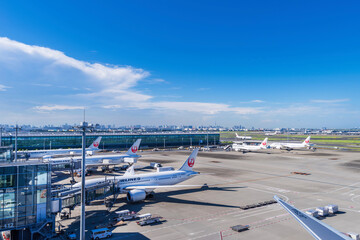
1981年ロサンゼルスに向け出発
May 20, 1978: Narita Airport Opens
1981: Departed for Los Angeles

太平洋上空
Above Pacific Ocean
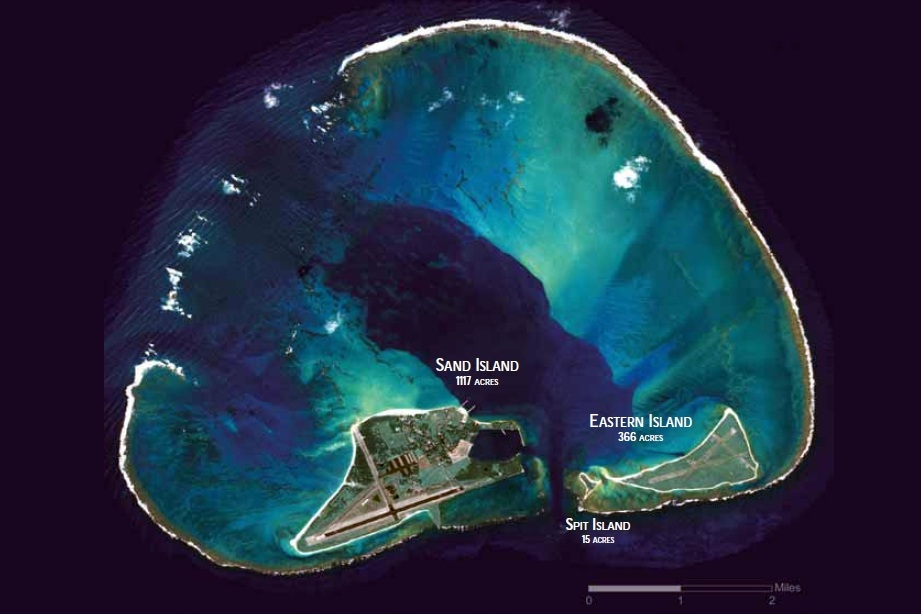
ミッドウェー島
Midway Atoll
ミッドウェー海戦
ミッドウェー海戦は、1942年6月5日かた6月7日にかけて中部太平洋ミッドウエー周辺で行われた日本海軍とアメリカ海軍による開戦である。太平洋戦の転換点と言われ、この戦闘における敗北により日本側は、制空権と制海権を失い、以後は戦争の主導権がアメリカ側に移った開戦として知られている。
The Battle of Midway
The Battle of Midway was a battle fought by the Japanese Navy and the American Navy around Midway Atoll in the central Pacific Ocean from June 5th to June 7th, 1942. It is said to be a turning point in the Pacific War, and the Japanese Navy suffered a crushing defeat in this battle, losing control of the skies and the sea. Since then, the initiative in the war shifted to the American side.
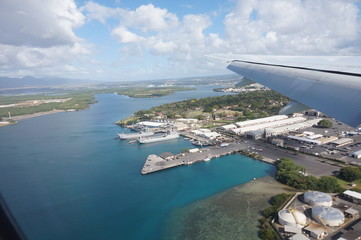
パールハーバー上空
The place where the Pacific War began: Aerial view of Peal Harbor
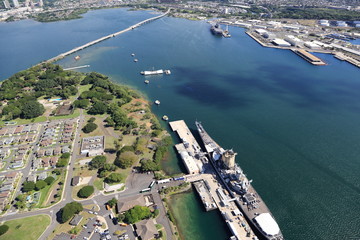
日本無条件降伏に調印した
アメリカ海軍戦艦ミズーリ号
The USS Missouri, the U.S. Navy battleship where the instrument of Japan’s unconditional surrender was signed.
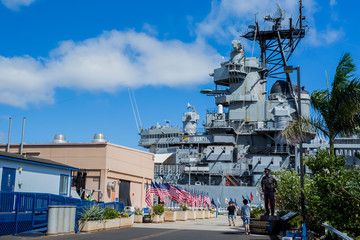
戦艦ミズーリ号
全長270.4メートル、最大幅33メートル、高さ66メートルの雄志
The magnificient figure of the Battleship Missouri: 270.4 meters in overall length, 33 meters in maximum beam, and 66 meters in height.
アメリカロサンゼルス編
表題タイトルに戻る
少年時代の夢がもたらしたもの アフリカ系アメリカ人ホテルマンから得た教訓
22歳、単身アメリカ・ホノルルへの旅
駆け出しの刑事であった私が、休暇を願い出て単身でアメリカへと旅立ったのは22歳の時でした。
当時は海外渡航が一般的ではなく、周囲からは「仕事も未熟な若僧のくせに刑事が休暇取ってアメリカだぁ」など猛反対され批判の声が上がりました。
それでも私は、共済組合からの借り入れを中心とした資金で渡米を決行しました。
結果として、お金では決して得られない貴重な経験が財産となりました。
まず訪れたのは、サンフランシスコの一流ホテル「フェアモントホテル」でした。総大理石造りの豪華なホテルで、私はバーで一人お酒を飲んでいました。
ふとトイレに立ち寄ると、そこは隅々まで磨き上げられ、清潔な空間が広がっていました。
「トイレを見ればその場所の状況がわかる」
捜査でよく耳にする言葉ですが、まさにその通りだと感心しました。
用を済ませ、手を洗っていると、背後に人の気配を感じました。振り返ると、タキシードを着たAfrican Americanの男性が、柔和な笑顔でタオルを差し出してくれたのです。
彼は私よりもはるかに年上の方でした。
一流ホテルならではのサービスに感銘を受け、“Thank you”と挨拶し手を拭きました。すると彼は、 “Excuse me, sir. Could you please wait a moment?”と声をかけ、私のスーツを丁寧にブラッシングしてくれたのです。それも、膝下まで入念に。
その細やかなサービスに驚くと同時に、若輩者の私には申し訳ないという気持ちが込み上げました。
チップを渡すのが当然の国で、私はお礼を言うのが精一杯でした。
男性は“My pleasure. Have a nice day!”と笑顔で応え、ドアを開けて見送ってくれました。
その時の彼の満面の笑顔は、今でも忘れられません。
彼にはきっと家族がいるはずです。アメリカはサービスに対してチップを支払う文化であり、彼はその収入で家族を養っていたはず。しかも、彼の職場は一日中トイレです。ですが、その笑顔には仕事への自信と誇りが溢れていました。きっと“I’m resposible for the restroom at the Fairmont Hotel.”(私の職場はフェアモントホテルのトイレです)と胸を張って言えるのでしょう。
どんな職業でも、どんな職場でも、置かれた場所で一生懸命に働く姿は美しい。
そして、笑顔には人を力づける素晴らしい力があることを、私は彼から学びました。
アメリカに入国して初めての夜のこと、チップの習慣に不慣れだった私は、ただ頭を下げるばかりでしたが、彼の笑顔は私の心に深く刻み込まれていました。
肌の色、国籍、生まれ育った場所、年齢、性別、障害の有無。そんなものは関係ない。差別はいけない。私は彼との出会いを通じて、そのことを痛感しました。そして、その時の思いを胸に、私は日々の仕事に取り組んでいます。もし、あの方と再会できるなら、改めてお礼を伝えたい。もしご存命ならば、100歳を超えていらっしゃることでしょうが、時を超えて伝えたい言葉があります。
それは只の”ありがとう”なんかじゃなくて、私の胸一杯に溢れる感謝と尊敬をあの頃に戻って直接お伝えしたいのです。
The Legacy of a Boyhood Dream: The Contribution of an African American Hotelier
A Solo Trip to Honolulu, USA at 22
I was a fledgling detective when I requested a vacation and took a solo trip to the United States, specifically to Honolulu, at the age of 22. At that time, overseas travel was not common, and I faced strong opposition and criticism from those around me, with comments like, “A young pup who’s still green on the job taking a vacation to America?” Nevertheless, I decided to go, funding my trip mainly with a loan from the mutual aid association.
As a result, I gained invaluable experiences that money could never buy.
My first stop was the Fairmont Hotel, a first-class hotel in San Francisco. It was a luxurious hotel made entirely of marble, and I was having a drink alone at the bar. When I went to the restroom, I found it to be a clean space, polished to every corner.
“You can tell the state of a place by its restrooms.”
It’s a saying I often heard in investigations, and I was impressed to see it was true. After finishing and washing my hands, I felt someone behind me. When I turned around, an African American man in a tuxedo offered me a towel with a gentle smile. He was much older than me.
I was impressed by the service unique to a first-class hotel and said, “Thank you,” as I dried my hands. Then he said, “Excuse me, sir. Could you please wait a moment?” and carefully brushed my suit, thoroughly down to my knees.
I was surprised by this meticulous service and at the same time felt apologetic as a young and inexperienced person. In a country where tipping is the norm, I could only express my gratitude.
The man responded with a smile, “My pleasure. Have a nice day!” and opened the door to see me off. His beaming smile at that moment is still unforgettable.
He must have had a family. In America, where tipping is customary for services, he was likely supporting his family with that income. Moreover, his workplace was the restroom all day. Yet, his smile was filled with confidence and pride in his work. He could surely say with pride, “I’m responsible for the restroom at the Fairmont Hotel.”
No matter the profession or workplace, the sight of someone working hard in their place is beautiful. And I learned from him that a smile has a wonderful power to energize people.
It was my first night in America, and being unfamiliar with the custom of tipping, I could only bow my head in thanks. But his smile was deeply etched in my heart.
Skin color, nationality, birthplace, age, gender, disability – none of that matters. Discrimination is wrong. Through my encounter with him, I deeply realized this. And with that feeling in my heart, I continue to work every day. If I could meet him again, I would like to express my gratitude once more. If he is still alive, he would be over 100 years old, but I have words to convey that transcend time.
It’s not just a simple “thank you.” It’s a deep sense of gratitude and respect overflowing from my heart, and I wish I could go back in time and tell you directly.
昨日、私が22才の頃 帰り来ぬ青春 〜

San Francisco
Golden Gate Bridge
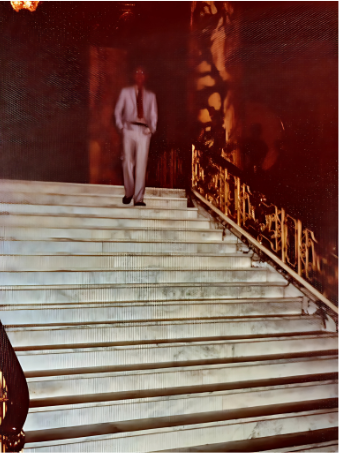
Fairmont Hotel Entrance Hall
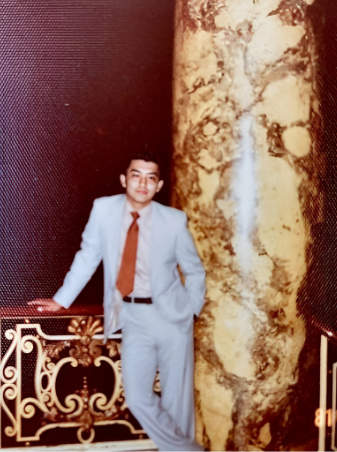
Fairmont Hotel
Marble
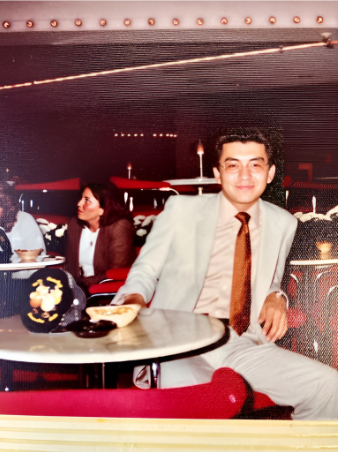
Cheers with Bourbon
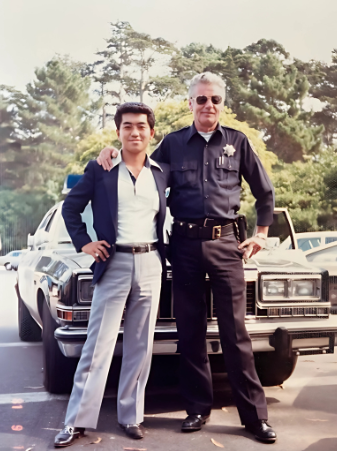
SFPD Officer

SFPD Mounted Officer
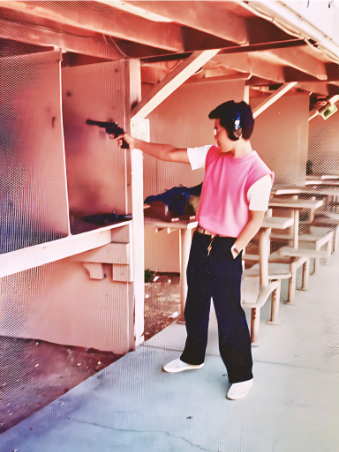
ピンクのポロシャツと銃
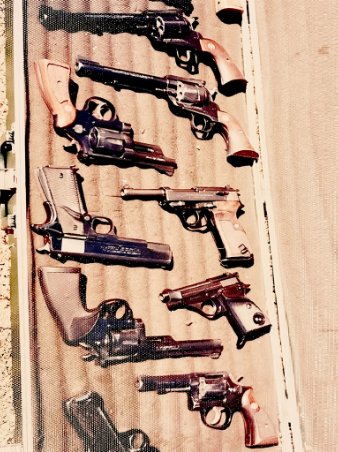
銃を持つ権利と課題

清水駅前交番赴任
初々しい巡査時代

静岡県警刑事二課時代
憧れの円谷幸吉記念館

円谷幸吉記念館
履物を揃えると〜
ピンクのポロシャツと銃
誤解が生んだ、まさかのヒーロー!
射撃場で華麗な腕前を披露する青年。その姿を見た者は、誰もが思った。「射撃が上手い日本のヤクザか半グレだろう!」。しかし、その予想は見事に裏切られる。「違う、日本の警官だ!」。
それでも、周囲は嘲笑し、その言葉を信じる者はいなかった。「え?マジで?冗談キツいっすよー」的な空気、ビンビンでしたね。
ピンクのポロシャツに黒いズボン、そして白いシューズ。一見、どこにでもいるような普通の青年。
しかし、彼が銃を構えた瞬間、その場の空気は一変する。
研ぎ澄まされた集中力、無駄のない動き。的を射抜くたびに、周囲からは感嘆の声が漏れる。「まさか、あの青年が…」。誰もがそう思っただろう。日本の警察官は、日々、市民の安全を守るために厳しい訓練と鍛錬を重ねている。しかし、その姿が一般の目に触れる機会は少ない。
だからこそ、この写真に写る青年の姿は、私たちに新鮮な驚きを与えてくれる。「射撃が上手いヤクザだろう?違う、日本の警官だ!」。この言葉は、私たちの固定観念を見事に打ち砕く。そして、同時に、私たちに問いかける。真のヒーローとは、一体どんな姿をしているのだろうか、と。
この写真に写る青年は、私たちに教えてくれる。ヒーローは、決して特別な存在ではない。普段はどこにでもいるような普通の人が、内に秘めた力で、私たちを守ってくれているのだと。
A Hero Born from Misunderstanding!
A man showcasing his brilliant marksmanship at a shooting range. Everyone who saw him thought, “He must be a Japanese Yakuza or a thug, he’s so good!” However, their expectations were completely overturned. “No, he’s a Japanese police officer!”
Even so, the people around him laughed and no one believed his words. There was a palpable atmosphere of “Seriously? You’ve got to be kidding me.”
Pink polo shirt, black trousers, and white shoes. At first glance, he looked like an ordinary young man you’d find anywhere. But the moment he held the gun, the atmosphere in the place changed completely.
A sharpened focus, movements without any waste. Every time he hit the target, voices of admiration leaked from the people around him. “No way, that young man…” Everyone must have thought so. Japanese police officers undergo rigorous training and discipline every day to protect the safety of citizens. However, there are few opportunities for the general public to see their skills.
That’s why the man in this photo gives us a fresh surprise. “A Yakuza with great shooting skills? No, a Japanese police officer!” These words shatter our stereotypes. And at the same time, they ask us, “What does a true hero look like?”
The man in this photo teaches us. A hero is not a special being. It’s an ordinary person you might find anywhere, who protects us with the power hidden within.
講演内容について
日本語・英訳 表題に戻る
子どもたちの健全育成を目指す
私は、青少年を取り巻く有害環境対策の推進として、青少年非行問題(虐め、自殺、性犯罪・被害、薬物乱用、非行行為等)の阻止に向け、小・中・高・専門学校・大学等の教育機関と連携し、非行防止と健全育成のための教育活動や啓発活動に取り組んでいます。
Aiming for the Healthy Development of Children
I am committed to educational and awareness activities for crime prevention and healthy development, in cooperation with educational institutions such as elementary, middle, and high schools, vocational schools, and universities. This is to promote measures against the harmful environment surrounding young people and to prevent juvenile delinquency problems (bullying, suicide, sexual crimes/victimization, drug abuse, delinquent behavior, etc.).
地域社会の安全対策
近年、振込詐欺やオレオレ詐欺、闇バイトといった特殊詐欺が多発しており、地域社会の安全が脅かされています。私は、これらの犯罪を未然に防ぎ、誰もが安心して暮らせる地域社会を実現するため、以下の活動を行っています。
防犯講演:地域自治体や各種団体からの依頼を受け、特殊詐欺の手口や対策について講演を行っています。
保護司活動:保護司として、犯罪や非行をした人の更生を支援し、社会復帰を促す活動を行っています。
行政手続き・相談業務:行政書士として、行政手続きに関する相談や書類作成のサポートを行っています。
これらの活動を通じて、地域の皆様の安全・安心な暮らしに貢献できるよう、尽力してまいります。
Community Safety Measures
In recent years, special frauds such as bank transfer fraud, “ore-ore” fraud, and “dark part-time jobs” have been occurring frequently, threatening the safety of local communities. To prevent these crimes and create a community where everyone can live in peace, I am engaged in the following activities:
Crime Prevention Lectures: Lecturing on the methods and countermeasures of special frauds at the request of local governments and various organizations.
Probation Officer Activities: Supporting the rehabilitation of people who have committed crimes or delinquency and promoting their reintegration into society as a probation officer.
Administrative Procedures and Consultation: Providing consultation on administrative procedures and support for document preparation as an administrative scrivener.
Through these activities, I will strive to contribute to the safe and secure lives of everyone in the community.
創作落語を用い防犯講話
防犯落語で地域を笑顔に!
34年間の刑事経験を活かし、地域の安全を守るために、落語を使った防犯講話を行っています。
防犯落語:笑いの中で防犯の知識が身につく、オリジナルの落語です。
薬学講座:学生向けに、薬物の危険性を分かりやすく解説します。
違法薬物講座:若年層を中心に、薬物の恐ろしさを訴えます。
闇バイト犯罪講座:最近増加している闇バイトの実態と危険性を解説します。
SNSトラブル講座:若年層が巻き込まれやすいSNSトラブルの事例と対策を紹介します。
その他、「家族の絆の大切さ」や「泥棒が嫌う家」など、地域に根ざしたテーマで講演活動を行っています。
Crime Prevention Lectures Using Creative Rakugo
Bringing smiles to the community with crime prevention rakugo!
Utilizing my 34 years of criminal investigation experience, I conduct crime prevention lectures using rakugo to protect the safety of the community.
Crime Prevention Rakugo: Original rakugo that teaches crime prevention knowledge through laughter.
Pharmacology Lectures: Explaining the dangers of drugs in an easy-to-understand manner for students.
Illegal Drug Lectures: Appealing to the younger generation about the dangers of drugs.
Dark Part-Time Job Crime Lectures: Explaining the reality and dangers of the increasing number of dark part-time jobs.
SNS Trouble Lectures: Introducing examples and countermeasures for SNS troubles that young people are prone to get involved in.
Other lecture themes rooted in the community, such as “The Importance of Family Bonds” and “Houses That Thieves Dislike.”
実践的企業コンプライアンス問題と対策
詳しくは、防犯講話にて記載
Practical Corporate Compliance Issues and Countermeasures
Corporate compliance is not limited to mere “legal compliance” but includes a wide range of elements such as ethics, morals, and social norms. Companies need to gain trust from society through fair and equitable business execution. This article explains the establishment of a corporate compliance system, violation cases and their risks, and preventive measures.
企業安全大会の講演
安全大会は、企業が従業員の安全意識を高め、労働災害の防止を目的として開催する集会です。
目的:
- 労働災害の防止
- 安全意識の向上
- 安全に関する知識の共有
- 法令遵守の徹底
内容:
- 安全講話:専門家や経験者による講演
- 安全表彰:安全活動に貢献した従業員の表彰
- 安全教育:具体的な事例を用いた教育や訓練
- 安全標語・スローガンの発表
- 安全に関する情報共有
開催時期:
多くの企業で、厚生労働省が定める「全国安全週間」(毎年7月1日~7日)の前後に開催されます。
対象者:
- 原則として、全従業員が対象ですが、業種や企業の規模によって異なります。
- 建設業などでは、取引先や関係会社の方も参加する場合があります。
その他:
- 近年では、新型コロナウイルス感染症対策として、オンラインでの開催や、参加人数を制限しての開催も増えています。
- 安全大会の開催は、労働安全衛生法で義務付けられているわけではありませんが、多くの企業が自主的に実施しています。
より詳しい情報を知りたい場合は、以下の情報も参考になるかと思います。
- 厚生労働省:労働安全衛生法
- 中央労働災害防止協会
Corporate Safety Conference Lecture
A safety conference is a gathering held by companies to raise employee safety awareness and prevent occupational accidents.
Purpose:
Prevention of occupational accidents
Improvement of safety awareness
Sharing of safety-related knowledge
Thorough compliance with laws and regulations
Contents:
Safety lectures: Lectures by experts and experienced individuals
Safety awards: Recognition of employees who have contributed to safety activities
Safety education: Education and training using specific examples
Announcement of safety slogans
Sharing of safety-related information
Timing:
Many companies hold these conferences around the time of “National Safety Week” (July 1-7 every year), as designated by the Ministry of Health, Labour and Welfare.
Target Audience:
In principle, all employees are targeted, but this varies depending on the industry and company size.
In industries such as construction, business partners and related companies may also participate.
Other:
In recent years, due to measures against COVID-19, there has been an increase in online conferences and conferences with limited participation.
Holding a safety conference is not mandated by the Industrial Safety and Health Act, but many companies implement it voluntarily.
The following information may be helpful if you would like to know more details.
Ministry of Health, Labour and Welfare: Industrial Safety and Health Act
Japan Industrial Safety and Health Association
保護司/行政書士として
そこには社会全体の本気の取り組みが求められます。
私は、罪を犯した全ての人を見捨てず、共に歩む保護司として活動しています。しかし、犯罪を犯した人は、少年院や刑務所で罪を償っても、「元受刑者」というレッテルを貼られ、周囲の偏見に晒されたり、就職を拒否されたりと、更生の機会を奪われることがあります。
真の更生とは、自らが招いた困難な状況を乗り越え、社会と真摯に向き合いながら、「自分にしかできない才能で人の役に立ち、喜びと誇りを取り戻す」ことだと考えます。
ノートルダム清心学園理事長、シスター渡辺和子さんの言葉「置かれた場所で咲きなさい」は、どのような状況でも希望を失わず、前向きに生きることの大切さを教えてくれます。
As a Probation Officer/Administrative Scrivener
As a probation officer, how should we face people who have committed crimes or delinquency after their release from prison and build a system to prevent recidivism? This requires a serious effort from the entire society.
I am working as a probation officer who does not abandon anyone who has committed a crime and walks with them. However, even if people who have committed crimes atone for their sins in juvenile training schools or prisons, they may be deprived of rehabilitation opportunities because they are labeled as “former inmates” and exposed to prejudice from those around them or refused employment.
I believe that true rehabilitation is to overcome the difficult situation one has brought upon oneself, sincerely face society, and “regain joy and pride by helping others with one’s unique talents.”
The words of Sister Kazuko Watanabe, Chairperson of the Board of Directors of Notre Dame Seishin Gakuen, “Bloom where you are planted,” teach us the importance of not losing hope and living positively in any situation.
講演活動のまとめ Summary of Speaking Engagement
講演活動について
子どもたちの健全育成を目指す
私は、青少年を取り巻く有害環境対策の推進として、青少年非行問題(虐め、自殺、性犯罪・被害、薬物乱用、非行行為等)の阻止に向け、小・中・高・専門学校・大学等の教育機関と連携し、非行防止と健全育成のための教育活動や啓発活動に取り組んでいます。
地域社会の安全対策
近年、振込詐欺やオレオレ詐欺、闇バイトといった特殊詐欺が多発しており、地域社会の安全が脅かされています。私は、これらの犯罪を未然に防ぎ、誰もが安心して暮らせる地域社会を実現するため、以下の活動を行っています。
防犯講演:地域自治体や各種団体からの依頼を受け、特殊詐欺の手口や対策について講演を行っています。
保護司活動:保護司として、犯罪や非行をした人の更生を支援し、社会復帰を促す活動を行っています。
行政手続き・相談業務:行政書士として、行政手続きに関する相談や書類作成のサポートを行っています。
これらの活動を通じて、地域の皆様の安全・安心な暮らしに貢献できるよう、尽力してまいります。
創作落語を用い防犯講話
防犯落語で地域を笑顔に!
34年間の刑事経験を活かし、地域の安全を守るために、落語を使った防犯講話を行っています。
防犯落語:笑いの中で防犯の知識が身につく、オリジナルの落語です。
薬学講座:学生向けに、薬物の危険性を分かりやすく解説します。
違法薬物講座:若年層を中心に、薬物の恐ろしさを訴えます。
闇バイト犯罪講座:最近増加している闇バイトの実態と危険性を解説します。
SNSトラブル講座:若年層が巻き込まれやすいSNSトラブルの事例と対策を紹介します。
その他、「家族の絆の大切さ」や「泥棒が嫌う家」など、地域に根ざしたテーマで講演活動を行っています。
実践的企業コンプライアンス問題と対策
企業に求められるコンプライアンスとは、単なる「法令遵守」に留まらず、倫理や道徳、社会規範といった幅広い要素を含みます。企業は、公正かつ公平な業務遂行を通じて、社会からの信頼を獲得する必要があります。本稿では、企業におけるコンプライアンス体制の構築、違反事例とそのリスク、そして予防策について解説します。
企業安全大会の講演
安全大会は、企業が従業員の安全意識を高め、労働災害の防止を目的として開催する集会です。
目的:
・労働災害の防止
・安全意識の向上
・安全に関する知識の共有
・法令遵守の徹底
内容:
・安全講話:専門家や経験者による講演
・安全表彰:安全活動に貢献した従業員の表彰
・安全教育:具体的な事例を用いた教育や訓練
・安全標語・スローガンの発表
・安全に関する情報共有
開催時期:
多くの企業で、厚生労働省が定める「全国安全週間」(毎年7月1日~7日)の前後に開催されます。
対象者:
・原則として、全従業員が対象ですが、業種や企業の規模によって異なります。
・建設業などでは、取引先や関係会社の方も参加する場合があります。
その他:
近年では、新型コロナウイルス感染症対策として、オンラインでの開催や、参加人数を制限しての開催も増えています。安全大会の開催は、労働安全衛生法で義務付けられているわけではありませんが、多くの企業が自主的に実施しています。
より詳しい情報を知りたい場合は、以下の情報も参考になるかと思います。
厚生労働省:労働安全衛生法
中央労働災害防止協会
保護司/行政書士として
保護司として、受刑者の出所後、いかに犯罪や非行を犯した人と向き合い、再犯を防ぐ仕組みを構築すべきか。そこには社会全体の本気の取り組みが求められます。
私は、罪を犯した全ての人を見捨てず、共に歩む保護司として活動しています。しかし、犯罪を犯した人は、少年院や刑務所で罪を償っても、「元受刑者」というレッテルを貼られ、周囲の偏見に晒されたり、就職を拒否されたりと、更生の機会を奪われることがあります。
真の更生とは、自らが招いた困難な状況を乗り越え、社会と真摯に向き合いながら、「自分にしかできない才能で人の役に立ち、喜びと誇りを取り戻す」ことだと考えます。
ノートルダム清心学園理事長、シスター渡辺和子さんの言葉「置かれた場所で咲きなさい」は、どのような状況でも希望を失わず、前向きに生きることの大切さを教えてくれます。
About My Activities
Aiming for the Healthy Development of Children
I am committed to educational and awareness activities for crime prevention and healthy development, in cooperation with educational institutions such as elementary, middle, and high schools, vocational schools, and universities. This is to promote measures against the harmful environment surrounding young people and to prevent juvenile delinquency problems (bullying, suicide, sexual crimes/victimization, drug abuse, delinquent behavior, etc.).
Community Safety Measures
In recent years, special frauds such as bank transfer fraud, “ore-ore” fraud, and “dark part-time jobs” have been occurring frequently, threatening the safety of local communities. To prevent these crimes and create a community where everyone can live in peace, I am engaged in the following activities:
Crime Prevention Lectures: Lecturing on the methods and countermeasures of special frauds at the request of local governments and various organizations.
Probation Officer Activities: Supporting the rehabilitation of people who have committed crimes or delinquency and promoting their reintegration into society as a probation officer.
Administrative Procedures and Consultation: Providing consultation on administrative procedures and support for document preparation as an administrative scrivener.
Through these activities, I will strive to contribute to the safe and secure lives of everyone in the community.
Crime Prevention Lectures Using Creative Rakugo
Bringing smiles to the community with crime prevention rakugo!
Utilizing my 34 years of criminal investigation experience, I conduct crime prevention lectures using rakugo to protect the safety of the community.
Crime Prevention Rakugo: Original rakugo that teaches crime prevention knowledge through laughter.
Pharmacology Lectures: Explaining the dangers of drugs in an easy-to-understand manner for students.
Illegal Drug Lectures: Appealing to the younger generation about the dangers of drugs.
Dark Part-Time Job Crime Lectures: Explaining the reality and dangers of the increasing number of dark part-time jobs.
SNS Trouble Lectures: Introducing examples and countermeasures for SNS troubles that young people are prone to get involved in.
Other lecture themes rooted in the community, such as “The Importance of Family Bonds” and “Houses That Thieves Dislike.”
Practical Corporate Compliance Issues and Countermeasures
Corporate compliance is not limited to mere “legal compliance” but includes a wide range of elements such as ethics, morals, and social norms. Companies need to gain trust from society through fair and equitable business execution. This article explains the establishment of a corporate compliance system, violation cases and their risks, and preventive measures.
As Corporate Safety Conference Lecture
A safety conference is a gathering held by companies to raise employee safety awareness and prevent occupational accidents.
Purpose:
Prevention of occupational accidents
Improvement of safety awareness
Sharing of safety-related knowledge
Thorough compliance with laws and regulations
Contents:
Safety lectures: Lectures by experts and experienced individuals
Safety awards: Recognition of employees who have contributed to safety activities
Safety education: Education and training using specific examples
Announcement of safety slogans
Sharing of safety-related information
Timing:
Many companies hold these conferences around the time of “National Safety Week” (July 1-7 every year), as designated by the Ministry of Health, Labour and Welfare.
Target Audience:
In principle, all employees are targeted, but this varies depending on the industry and company size.
In industries such as construction, business partners and related companies may also participate.
Other:
In recent years, due to measures against COVID-19, there has been an increase in online conferences and conferences with limited participation.
Holding a safety conference is not mandated by the Industrial Safety and Health Act, but many companies implement it voluntarily.
The following information may be helpful if you would like to know more details.
Ministry of Health, Labour and Welfare: Industrial Safety and Health Act
Japan Industrial Safety and Health Association
As a Probation Officer/Administrative Scrivener
As a probation officer, how should we face people who have committed crimes or delinquency after their release from prison and build a system to prevent recidivism? This requires a serious effort from the entire society.
I am working as a probation officer who does not abandon anyone who has committed a crime and walks with them. However, even if people who have committed crimes atone for their sins in juvenile training schools or prisons, they may be deprived of rehabilitation opportunities because they are labeled as “former inmates” and exposed to prejudice from those around them or refused employment.
I believe that true rehabilitation is to overcome the difficult situation one has brought upon oneself, sincerely face society, and “regain joy and pride by helping others with one’s unique talents.”
The words of Sister Kazuko Watanabe, Chairperson of the Board of Directors of Notre Dame Seishin Gakuen, “Bloom where you are planted,” teach us the importance of not losing hope and living positively in any situation.
表題タイトルに戻る
保護司として生きる大切さを教えたい
光射す未来を、共に信じて。
保護司として、私は受刑者の出所後、いかに彼らが再び社会で光り輝けるかを、日々考えています。
過ちを犯した彼らも、私たちと同じ人間です。少年院や刑務所で罪を償ったとしても、「元受刑者」というレッテルが、彼らの未来を閉ざしてしまう現実があります。
周囲の偏見、就職の拒否。彼らは社会から孤立し、再び暗闇へと引き戻されそうになります。
しかし、私は信じています。真の更生とは、自らが困難を乗り越え、社会と繋がり、自らの才能で誰かの役に立つことだと。
ノートルダム清心学園理事長、シスター渡辺和子さんの言葉「置かれた場所で咲きなさい」。
この言葉は、どんな状況でも希望を捨てず、前を向いて生きることの大切さを教えてくれます。
彼らの未来を信じ、光射す場所へ共に歩む。
そこには、社会全体の温かいまなざしと、彼らを信じる力が不可欠なのです。
As a Probation Officer, Bloom Where You Are Planted
Believing Together in a Future Filled with Light.
As a probation officer, I constantly contemplate how I can help former inmates shine brightly in society once again after their release.
Those who have made mistakes are human beings just like us. Even if they have served their time in juvenile detention or prison, the label of “former inmate” can close doors to their future.
Surrounded by prejudice and denied employment, they become isolated from society, facing the threat of being dragged back into darkness.
However, I believe that true rehabilitation means overcoming their own hardships, reconnecting with society, and contributing to others with their unique talents.
The words of Sister Kazuko Watanabe, Chairperson of Notre Dame Seishin University, “Bloom where you are planted,” teach us the importance of not giving up hope and moving forward, no matter the circumstances.
Believing in their future, we walk together towards a place filled with light.
For that, we need the warm support of society as a whole and the power to believe in them.
NHK アーカイブス
ノートルダム清心学園
理事 渡辺和子さん
NHK アーカイブス
渡辺和子さん
置かれた場所で咲きなさい
キリスト教の香り
渡辺和子さん
置かれた場所で咲きなさい
過去には戻れないけど、この曲で一人泣き人生を見つめ直した人たち〜
A氏 過ちという罪を犯して どんな人の心にも
B氏 刑を終えて 何もいいことなどなったこの街で
C氏 償い 許されていいのですか
表題タイトルに戻る
少年審判で裁判官は償いを聴かせた
この詩は、さだまさし氏が、心の奥底にそっと触れるように紡ぎ出した、真実の物語です。
それは、まるで静かな湖面に映る月のように、聴く者の心を深く揺さぶります。
物語の中心にいるのは、交通事故で最愛の伴侶を失った女性(歌の中では「被害者の奥さん」)と、事故を起こしてしまった「ゆうちゃん」という名の男性。「ゆうちゃん」は、心の優しい、どこにでもいるような人でした。
しかし、彼が起こしてしまった事故は、彼自身の、そして残された女性の人生を大きく変えてしまいます。
彼は、自らの罪を償うため、毎月、少しずつお金を送り続けました。それは、まるで懺悔のようであり、贖罪のようでもありました。女性が経済的に立ち直った後も、彼の償いは続きました。
手紙が届くたび、女性の心には、夫への愛と、失われた時間への悲しみが押し寄せます。ついに彼女は、「もうお金は送らなくてもいい」と手紙を書きました。しかし、「ゆうちゃん」の償いは、止まることを知りませんでした。
さだまさしからのメッセージ
この詩は、2001年に東京で起きた、悲しい事件の裁判で、再び光を当てられました。
酔った男の人と口論になった少年たちが、手を出してしまい、取り返しのつかない殺人事件を招いてしまったのです。裁判で、少年たちは反省の弁を口にしましたが、その言葉は、建前だけの謝罪でした。
2002年2月19日、裁判長は、少年たちに語りかけました。「君たちは、さだまさしの『償い』という歌を知っているだろうか」と。それは、心の奥底に響く、静かな問いかけでした。裁判長の言葉は、少年の心の奥底に、静かに、しかし確実に響いたことでしょう。
さだまさし氏は言いました。「法律は、人の心を裁くには限界がある。この歌の若者は、命がけで償おうとした。裁判長は、それを伝えたかったのではないか」と。
「償い」は、ただの歌ではありません。それは、人間の心の奥底にある、罪、償い、そして許しについて、私たちに静かに語りかけてくる、魂の物語なのです。
Atonement: The song a judge played for a juvenile in juvenile court, showing what it truly means to atone.
This poem is a true story, gently woven by Masashi Sada to touch the depths of our hearts. It stirs the soul as deeply as the moon reflected on a still lake. At the center of the story are a woman (referred to as “the victim’s wife” in the song) who lost her beloved partner in a traffic accident, and a man named “Yu-chan” who caused the accident. Yu-chan was a kind-hearted, ordinary person. However, the accident he caused drastically changed his life and the life of the woman he left behind. To atone for his sin, he continued to send her small amounts of money every month. It was like a confession, a redemption. Even after the woman financially recovered, his atonement continued.
Each time a letter arrived, the woman’s heart was flooded with love for her husband and grief for the lost time. Finally, she wrote a letter saying, “You don’t have to send any more money.” But Yu-chan’s atonement never ceased.
The song a judge played for a juvenile who committed murder in juvenile court.
This poem was brought to light again in the trial of a tragic incident that occurred in Tokyo in 2001.
Juveniles who got into an argument with a drunk man resorted to violence, resulting in an irreversible murder. In court, the juveniles expressed remorse, but their words were merely perfunctory apologies.
On February 19, 2002, the presiding judge addressed the juveniles, “Do you know the song ‘Atonement’ by Masashi Sada?” It was a quiet question that resonated deep within their hearts. The judge’s words must have quietly but surely echoed in the depths of the juveniles’ souls.
Masashi Sada said, “The law has limitations in judging the human heart. The young man in this song tried to atone with his life. I think the judge wanted to convey that.”
“Atonement” is not just a song. It is a story of the soul that quietly speaks to us about sin, atonement, and forgiveness, which lie deep within the human heart.
表題タイトルに戻る
講演実績
暴力追放推進協議会・保護司会・福祉協議会・富士信用金庫・東京ソラマチ・日本モータボート競走会
千葉県・奈良県・静岡市・沼津市・富士市・富士宮市・牧之原市・各自治会/町内会・各種企業等。
出演メディア
【テレビ】
NHK:特番「防犯・更生」テレビ朝日特番「第二の人生は落語家」テレビ静岡/特番「落語家は元警察官」生出演 静岡第一テレビ/特番 夢授業・警察24時 YouTube/ルー大柴の健活TVニュース番組
【新聞】
日本経済新聞・読売新聞・朝日新聞・毎日新聞・中日新聞・静岡新聞・日刊警察察
【雑誌】
演劇グラフ(奈良県での出演を紹介)
【ラジオ】
FMマリンパルしみず(レギュラー出演)SBS静岡放送(レギュラー出演)富士/ K-mix静岡各局
Lecture Achievements
・Violence Eradication Promotion Council
・Probation Officers Association
・Welfare Council・Fuji Shinkin Bank
・Tokyo Solamachi・Japan Motorboat Racing Association
・Chiba Prefecture
・Nara Prefecture
・Shizuoka City
・Numazu City
・Fuji City
・Fujinomiya City
・Makinohara City
・Various Neighborhood Associations/Town Councils
・Various Companies, etc.
Media Appearances
【Television】
・NHK: Special “Crime Prevention and Rehabilitation”
・TV Asahi Special: “A Second Life as a Rakugo Performer”
・TV Shizuoka Special: “Rakugo Performer is a Former Police Officer”
・Live Appearance: Shizuoka Daiichi Television/Special Dream Class, Police 24 Hours
・YouTube: Lou Oshiba’s Health Activity TV News Program
【Newspapers】
・Nikkei Inc.
・Yomiuri Shimbun
・Asahi Shimbun
・Mainichi Shimbun
・Chunichi Shimbun
・Shizuoka Shimbun
・Nikkan Keisatsu (Daily Police Newspaper)
【Magazines】
・Engeki Graph (Introduced performance in Nara Prefecture)
【Radio】
・FM Marinepal Shimizu (Regular appearance)
・SBS Shizuoka Broadcasting (Regular appearance)
・Fuji/K-mix Shizuoka Various stations
